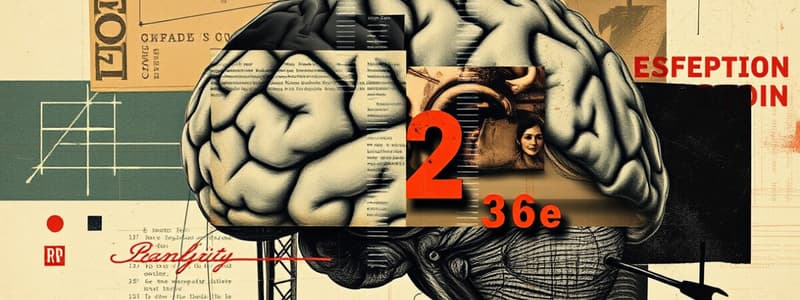Podcast
Questions and Answers
What primary function does the right superior frontal gyrus (SFG) assist with?
What primary function does the right superior frontal gyrus (SFG) assist with?
- Cognitive control
- Language processing
- Speech production
- Social cognition (correct)
Which function is predominantly associated with the left superior frontal gyrus (SFG)?
Which function is predominantly associated with the left superior frontal gyrus (SFG)?
- Emotion regulation
- Language processing (correct)
- Executive functions related to spatial awareness
- Motor control
How do the right and left superior frontal gyri differ in terms of spatial awareness?
How do the right and left superior frontal gyri differ in terms of spatial awareness?
- The left SFG is more involved in spatial awareness.
- Neither SFG is related to spatial awareness.
- The right SFG has a stronger role in spatial awareness. (correct)
- Both SFGs are equally involved in spatial awareness.
Which of the following is NOT a function associated with the right superior frontal gyrus (SFG)?
Which of the following is NOT a function associated with the right superior frontal gyrus (SFG)?
What aspect of cognitive control is emphasized by the left superior frontal gyrus (SFG)?
What aspect of cognitive control is emphasized by the left superior frontal gyrus (SFG)?
Which of the following functions is shared by both the left and right superior frontal gyri (SFG)?
Which of the following functions is shared by both the left and right superior frontal gyri (SFG)?
What primary role does the left SFG play in relation to executive functions?
What primary role does the left SFG play in relation to executive functions?
In what way is the right superior frontal gyrus (SFG) more involved than the left in the context of emotional regulation?
In what way is the right superior frontal gyrus (SFG) more involved than the left in the context of emotional regulation?
Flashcards are hidden until you start studying
Study Notes
Superior Frontal Gyrus (SFG)
- Comprises two hemispheres: right SFG and left SFG, each with distinct functions.
Right Superior Frontal Gyrus (SFG)
- Executive Functions: Aids in decision-making, planning, and attention focus.
- Self-Awareness: Contributes to awareness of one’s actions and thoughts, enhancing conscious experiences.
- Emotion Regulation: Helps manage emotions, stress, and impulse control.
- Motor Control: Involved in planning and executing voluntary movements.
- Social Cognition: Facilitates understanding of others' intentions and improves social interactions.
- Integrates cognitive, emotional, and motor processes vital for diverse behaviors and mental activities.
Left Superior Frontal Gyrus (SFG)
- Language Processing: Key role in speech production and grammar, located near Broca’s area.
- Executive Functions: Handles decision-making, planning, working memory, and attention, especially for verbal tasks.
- Cognitive Control: Aids in inhibiting inappropriate responses and maintaining focus.
- Internal Thought Processes: Associated with introspection and logical reasoning.
- Motor Planning: Crucial for planning speech-related movements and fine motor skills on the body's right side.
- Focused on language, executive functions, cognitive control, and motor planning, emphasizing verbal and logical tasks.
Similarities between Right and Left SFG
- Both are involved in executive functions, self-awareness, emotion regulation, and motor control.
Differences between Right and Left SFG
- Left SFG is more language-oriented due to proximity to Broca’s area, while right SFG has less focus on language tasks.
- Right SFG enhances spatial awareness, while left SFG concentrates on internal cognitive processes.
- Right SFG is more attuned to understanding others' intentions; left SFG is less so.
Studying That Suits You
Use AI to generate personalized quizzes and flashcards to suit your learning preferences.




